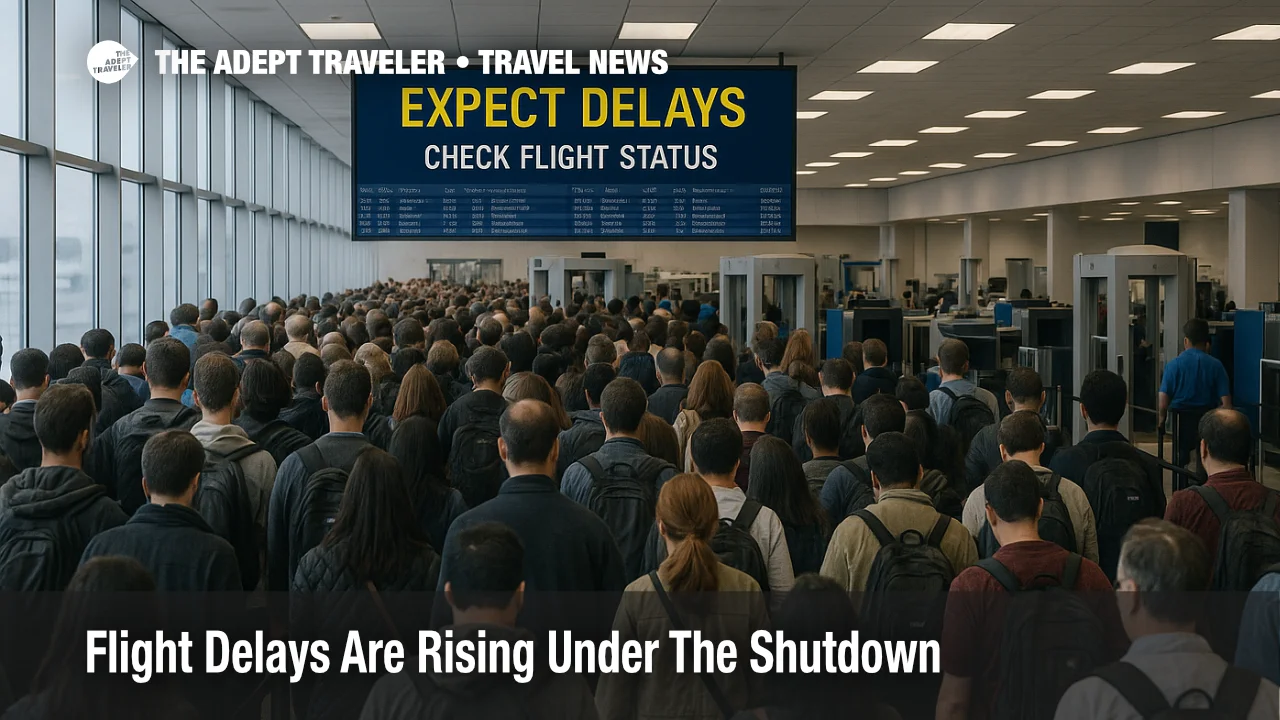Flight Delays Are Rising Under The Shutdown

Key points
- Delays jumped late week as FAA slowed traffic at multiple facilities due to staffing gaps
- Thursday saw more than seven thousand U.S. delays, followed by thousands more on Friday
- FAA issued ground-delay programs at hubs including Dallas Fort Worth and Austin
- Controller absences now account for a far larger share of delays than before the shutdown
- Expect rolling metering in the Northeast and Texas plus longer lines during peak TSA banks
Impact
- Flights
- Build extra buffer on connections and favor early nonstop departures
- Airports
- Watch FAA ground delay and flow programs at New York, DC, Dallas, Houston and Austin
- Security
- Leave more time for TSA, especially mid-morning and late-afternoon waves
- Weekend
- If funding stalls, delays are likely to widen and last longer through late week
- WhatToDo
- Enable airline app alerts, monitor FAA advisories, and consider nearby airports
As the federal shutdown stretches into Saturday, November 1, travelers are feeling it at the checkpoints and on the tarmac, where air traffic control facilities are metering flights and TSA staffing is strained by unpaid shifts. The FAA has leaned on ground-delay programs and conservative spacing to preserve safety, which has pushed wait times higher and rippled delays through busy hubs in the Northeast and Texas, with weather turning small staffing gaps into larger slowdowns. Over the last few days the pattern has been consistent, longer lines and rolling schedule holds during peak banks, followed by downstream disruptions that last into the evening. If the funding lapse continues, expect more of the same in the week ahead, with the best odds of on-time departures coming from early, nonstop flights and extra buffer on any connections.
What we're seeing in the data
The clearest signal is the step-up in delays tied to controller staffing. By Thursday, October 30, U.S. airlines logged more than 7,300 delays and over 1,200 cancellations, according to FlightAware data cited by national outlets, with FAA conserving safety by slowing traffic at key facilities.
On Friday, October 31, the FAA again imposed metering and ground-delay programs. Reuters reported midday more than 2,200 U.S. delays and about 300 cancellations, noting airports from Austin to Newark and Nashville posting average delays of 50 to 101 minutes as staffing notices went up.
Local reports match the national trend. At Dallas Fort Worth, staffing led to a Halloween ground-delay program with more than 180 delays as of mid-afternoon. In Austin, arrivals were held most of the day under an FAA ground delay, with average waits near 50 minutes and more than a hundred delays by late morning.
Today, Saturday, November 1, FlightAware's live dashboard continues to show elevated activity, with thousands of global delays and hundreds in the U.S., consistent with FAA traffic-management steps when facilities are short. (Figures on the live page update throughout the day.)
Why delays are increasing
Controllers, TSA officers, and other essential staff must work without pay during a lapse, but attendance has slipped as the shutdown drags on. Transportation officials and multiple reports say controller absences have become a primary cause of delays this week, accounting for roughly 44 percent of delays Sunday and 24 percent Monday, compared with about 5 percent before the shutdown.
The FAA was already about 3,500 controllers short of target staffing going into the shutdown, which magnifies the impact when even a small number are out. With fewer people on position, facilities reduce arrival rates, space aircraft more conservatively, and run ground-delay programs that ripple into downstream hubs.
Where the pain has clustered
- Northeast corridor: New York area airports, plus Newark and Washington, have seen repeated metering when staffing and winds coincide.
- Texas: Dallas Fort Worth and Houston have cycled through flow controls, with Austin seeing full arrival ground delays on Friday.
- Weather amplifiers: When wind or ceilings drop, the staffing cushion is thin, so delays lengthen faster than in a normal week.
The next week: realistic expectations
If funding remains unresolved, expect rolling FAA initiatives at the busiest airspace, especially New York, Washington National, Chicago O'Hare, Dallas Fort Worth, Houston Intercontinental, and Austin, with the longest holds during peak push periods. Arrive early, target first-bank departures, avoid tight connections, and use airline apps for rebooking when metering extends.
Sources
- Washington Post, "Flight delays, airport disruption fears grow as shutdown drags on"
- Reuters, "U.S. expects more flight disruptions as shutdown enters Day 31" (Oct. 31, 2025)
- FAA, "Lapse in Appropriations" notice
- U.S. DOT, "Plans for Operations During a Lapse in Annual Appropriations" (PDF)
- Airlines for America, "Statement on White House Meeting"
- NATCA, "End the Government Shutdown Immediately"
- TIME, "Flight Delays Mount as Government Shutdown Leaves Controllers Working Without Pay"
- WWNY, "TSA warns of severe impact as shutdown continues"
- WFAA, "Staffing leads to ground delay at DFW Airport" (Oct. 31, 2025)
- MySA, "FAA ground delay at Austin-Bergstrom International Airport" (Oct. 31, 2025)
- Business Insider, "ATC shortages pile up, causing delays"
- FlightAware, "Live Airline Delay and Cancellation Statistics"
